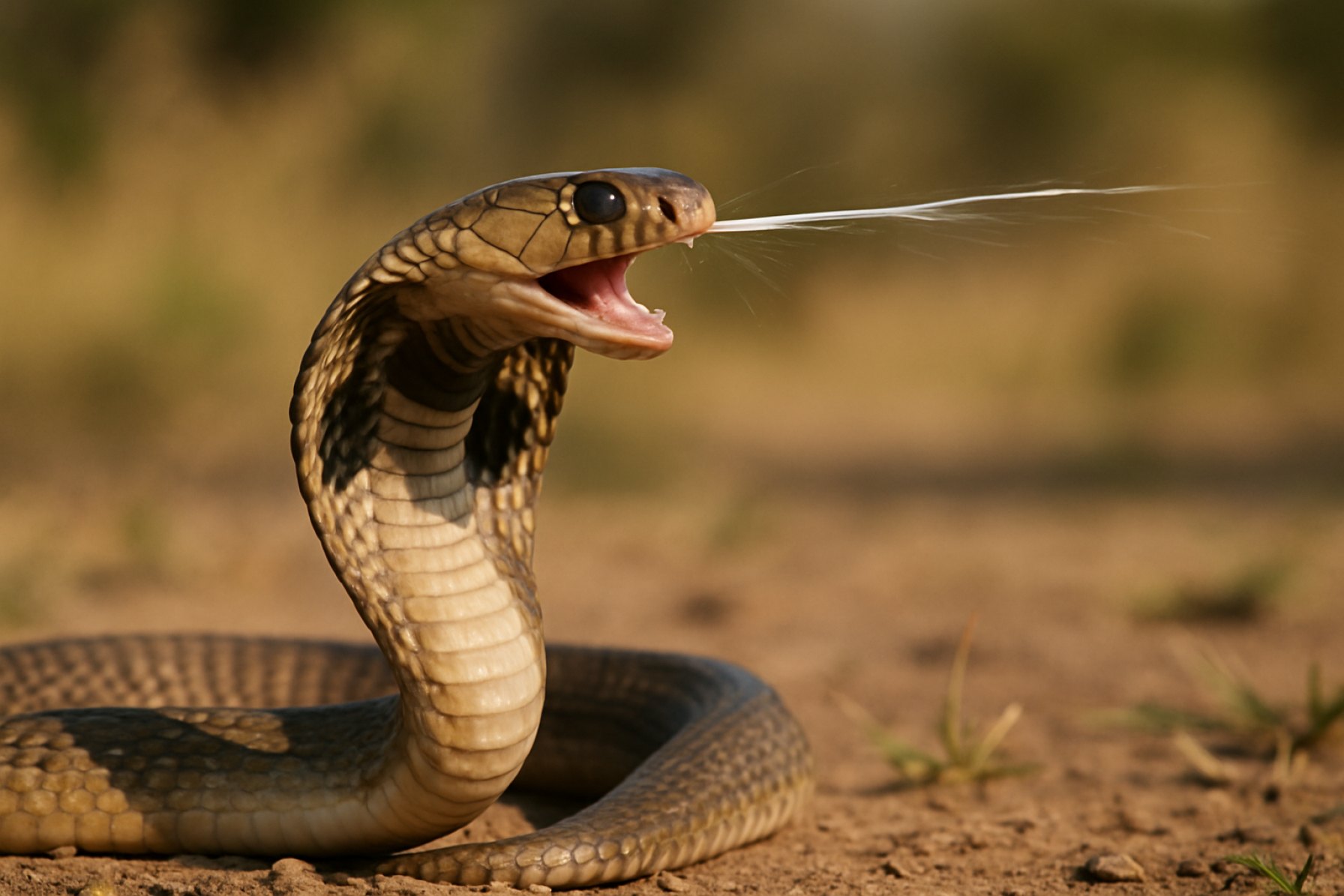
The Mozambique Spitting Cobra: Africa’s Deadly Spitter and Its Astonishing Survival Tactics. Discover How This Elusive Snake Defends, Hunts, and Thrives in the Wild.
- Introduction: Meet the Mozambique Spitting Cobra
- Physical Characteristics and Identification
- Habitat and Geographic Distribution
- Venom Composition and Spitting Mechanism
- Hunting Strategies and Diet
- Defensive Behaviors and Human Encounters
- Ecological Role and Predators
- Conservation Status and Threats
- Fascinating Facts and Myths
- Safety Tips and First Aid for Spitting Cobra Encounters
- Sources & References
Introduction: Meet the Mozambique Spitting Cobra
The Mozambique Spitting Cobra (Naja mossambica) is one of Africa’s most remarkable and adaptable venomous snakes, renowned for its unique defensive behavior and potent venom. Native to sub-Saharan Africa, particularly in Mozambique, Zimbabwe, South Africa, and neighboring regions, this species thrives in a variety of habitats, from savannas and woodlands to agricultural areas and even human settlements. Its adaptability has contributed to its widespread presence and frequent encounters with people, making it a significant species in both ecological and medical contexts.
What sets the Mozambique Spitting Cobra apart from many other snakes is its ability to eject venom with remarkable accuracy, targeting the eyes of potential threats from distances of up to two meters. This defensive mechanism can cause intense pain and temporary or even permanent blindness if not promptly treated. Despite its fearsome reputation, the cobra is generally shy and prefers to escape rather than confront humans, resorting to spitting or biting only when cornered or provoked.
The species plays a vital role in controlling rodent and amphibian populations, thus maintaining ecological balance. However, its proximity to human habitation often leads to conflict, resulting in snakebite incidents that pose public health challenges in affected regions. Understanding the biology, behavior, and ecological significance of the Mozambique Spitting Cobra is crucial for both conservation efforts and the development of effective medical responses to envenomation. For more detailed information, refer to resources from the International Union for Conservation of Nature and the Natural History Museum.
Physical Characteristics and Identification
The Mozambique Spitting Cobra (Naja mossambica) is a medium-sized, highly distinctive elapid snake native to sub-Saharan Africa. Adults typically measure between 90 and 150 centimeters in length, though some individuals can exceed 180 centimeters. The body is moderately slender, with smooth scales that give the snake a glossy appearance. Coloration varies, but most specimens display a pale to dark gray or brown dorsal surface, often with irregular black or olive banding, especially in juveniles. The ventral side is usually lighter, ranging from creamy white to pale yellow, sometimes marked with dark blotches or bars.
A key identification feature is the broad, flattened head, which is only slightly distinct from the neck. When threatened, the Mozambique Spitting Cobra can expand its neck ribs to form a characteristic hood, though this hood is generally narrower than that of the true cobras (Naja species) found in Asia. The eyes are large with round pupils, and the snake possesses prominent, forward-facing fangs adapted for both biting and spitting venom.
One of the most distinctive behaviors aiding identification is its ability to eject venom accurately at the eyes of perceived threats, often from a distance of up to 2–3 meters. This defensive mechanism is unique among African cobras and is a critical field mark for distinguishing the species. The combination of coloration, hood display, and spitting behavior makes the Mozambique Spitting Cobra relatively easy to identify in its natural habitat International Union for Conservation of Nature Natural History Museum.
Habitat and Geographic Distribution
The Mozambique Spitting Cobra (Naja mossambica) is widely distributed across sub-Saharan Africa, with its range primarily encompassing southeastern Africa. This species is commonly found in countries such as Mozambique, South Africa, Zimbabwe, Botswana, Malawi, Tanzania, and parts of Eswatini. Its habitat preferences are notably diverse, allowing it to thrive in a variety of environments. The cobra is most frequently encountered in savannas, woodlands, and scrublands, but it also adapts well to agricultural areas and even peri-urban settings, provided there is sufficient cover and access to water sources.
The Mozambique Spitting Cobra favors habitats with loose, sandy soils that facilitate burrowing and provide shelter. It often seeks refuge in termite mounds, rodent burrows, hollow logs, or under rocks. Proximity to water is a significant factor in its habitat selection, as the species is known to be an adept swimmer and is often found near rivers, streams, or seasonal pans. This adaptability to both dry and moist environments contributes to its widespread presence across its range.
Despite its adaptability, the species is less common in dense forests and arid deserts, where suitable shelter and prey are limited. Human encroachment and habitat modification have led to increased encounters between the Mozambique Spitting Cobra and people, particularly in rural and agricultural landscapes. Nevertheless, the species remains relatively abundant and is not currently considered threatened, thanks to its ecological flexibility and broad distribution International Union for Conservation of Nature.
Venom Composition and Spitting Mechanism
The venom of the Mozambique Spitting Cobra (Naja mossambica) is a complex mixture of neurotoxins, cytotoxins, and cardiotoxins, with a significant emphasis on cytotoxic components. These cytotoxins are responsible for the severe local tissue damage and necrosis often observed following envenomation. The neurotoxic elements, while present, are less potent than those found in some other cobra species, but can still cause systemic symptoms such as drowsiness, respiratory distress, and, in rare cases, paralysis. The venom also contains enzymes like phospholipase A2, which contribute to both the cytotoxic and neurotoxic effects by disrupting cell membranes and interfering with nerve transmission National Center for Biotechnology Information.
The Mozambique Spitting Cobra is renowned for its unique defensive behavior: the ability to eject venom from its fangs towards the eyes of a perceived threat. This spitting mechanism is facilitated by specialized adaptations in the fangs, which have forward-facing orifices. When threatened, the cobra contracts muscles around its venom glands, forcing venom through these orifices in a fine spray. The accuracy of this spitting can reach up to two meters, and the primary aim is to cause intense pain and potential temporary or permanent blindness if the venom contacts the eyes. This adaptation serves as an effective deterrent against predators and is a hallmark of several African spitting cobra species Natural History Museum.
Hunting Strategies and Diet
The Mozambique Spitting Cobra (Naja mossambica) employs a combination of stealth, agility, and specialized venom delivery to secure its prey. Primarily nocturnal, this cobra actively hunts at night, using its keen sense of smell and heat-sensitive abilities to locate potential food sources. Its diet is notably diverse, including amphibians, birds, eggs, small mammals, and other reptiles, such as lizards and even other snakes. Opportunistic in nature, the Mozambique Spitting Cobra adapts its hunting strategies based on prey availability and environmental conditions.
One of the cobra’s most distinctive hunting adaptations is its ability to spit venom with remarkable accuracy, targeting the eyes of potential threats or prey from distances up to 2.5 meters. While spitting is primarily a defensive behavior, the venom can also be used to subdue prey, especially when the snake is cornered or the prey is particularly large or aggressive. The venom contains both neurotoxic and cytotoxic components, which immobilize and begin digesting the prey even before ingestion.
After striking or spitting, the cobra often waits for the venom to take effect before consuming its prey whole. This method reduces the risk of injury from struggling animals. The Mozambique Spitting Cobra’s flexible jaw structure allows it to swallow prey much larger than its head. Its adaptability in both diet and hunting technique has contributed to its success across a wide range of habitats in sub-Saharan Africa International Union for Conservation of Nature Natural History Museum.
Defensive Behaviors and Human Encounters
The Mozambique Spitting Cobra (Naja mossambica) is renowned for its sophisticated defensive behaviors, particularly its ability to eject venom with remarkable accuracy. When threatened, this cobra raises the anterior part of its body, flattens its neck into a hood, and directs a stream of venom toward the eyes of a perceived aggressor. The venom can be projected up to 2–3 meters, and its primary function is to deter predators by causing intense pain and potential temporary or permanent blindness if it contacts the eyes. This spitting behavior is typically accompanied by hissing and mock strikes, serving as additional warnings before resorting to biting IUCN Red List.
Human encounters with the Mozambique Spitting Cobra are relatively common in its native range, which includes savannas, woodlands, and areas near human settlements in southern Africa. Most incidents occur when the snake is accidentally cornered or surprised, prompting it to spit defensively. While fatalities from bites are rare due to the snake’s preference for escape and its reliance on spitting, envenomation can cause severe local tissue damage and necrosis if a bite does occur. Ocular exposure to venom requires immediate and thorough irrigation to prevent lasting injury World Health Organization. Public education on snake behavior and first aid is crucial in reducing the risk and severity of human-cobra conflicts South African National Biodiversity Institute.
Ecological Role and Predators
The Mozambique Spitting Cobra (Naja mossambica) plays a significant ecological role within its native habitats across sub-Saharan Africa. As a mid-level predator, it helps regulate populations of small mammals, amphibians, birds, and other reptiles, including other snakes. This predatory behavior contributes to maintaining a balanced ecosystem by controlling potential pest species and supporting the food web’s complexity. The cobra’s diet also includes carrion, which aids in nutrient recycling and the decomposition process within its environment (International Union for Conservation of Nature).
Despite its potent venom and defensive spitting behavior, the Mozambique Spitting Cobra faces predation from several larger animals. Notably, birds of prey such as secretary birds and certain raptors are adept at hunting and consuming these snakes. Mammalian predators, including mongooses and honey badgers, are also known to prey on cobras, often displaying remarkable resistance to their venom. Juvenile cobras are particularly vulnerable to a wider range of predators, including monitor lizards and larger snakes (South African National Biodiversity Institute).
The presence of the Mozambique Spitting Cobra thus influences both prey and predator populations, shaping the dynamics of the ecosystems it inhabits. Its interactions with other species underscore its importance as both a predator and prey, highlighting the intricate balance of natural communities in African savannas and woodlands.
Conservation Status and Threats
The Mozambique Spitting Cobra (Naja mossambica) is currently classified as “Least Concern” on the IUCN Red List, reflecting its relatively wide distribution and presumed large population across southern and eastern Africa. Despite this status, the species faces several localized threats that could impact its populations in the future. Habitat loss due to agricultural expansion, urbanization, and deforestation is a significant concern, as these activities reduce the availability of suitable environments for the cobra to hunt and shelter. Additionally, the Mozambique Spitting Cobra is often killed on sight by humans due to fear of its potent venom and defensive spitting behavior, which can cause severe injury, particularly to the eyes of humans and domestic animals.
Another threat comes from the illegal wildlife trade, where cobras are sometimes captured for use in traditional medicine, the exotic pet trade, or for their skins. While these pressures are not currently causing a rapid decline in the overall population, they may have more pronounced effects in certain regions where human-cobra conflict is high or where habitat fragmentation is severe. Conservation efforts for the Mozambique Spitting Cobra are limited, but the species does occur in several protected areas, which helps buffer some of the threats it faces. Continued monitoring and public education are recommended to ensure that populations remain stable and to reduce unnecessary killings due to misunderstanding or fear of the species International Union for Conservation of Nature South African National Biodiversity Institute.
Fascinating Facts and Myths
The Mozambique Spitting Cobra (Naja mossambica) is surrounded by a blend of fascinating facts and enduring myths, making it one of Africa’s most intriguing serpents. Notably, this species is renowned for its unique defensive behavior: it can eject venom with remarkable accuracy up to 2-3 meters, aiming for the eyes of perceived threats. This adaptation is not only a deterrent but can cause temporary or even permanent blindness if not promptly treated, underscoring the importance of immediate medical attention in the event of exposure Natural History Museum.
A common myth suggests that the Mozambique Spitting Cobra is highly aggressive and will chase humans. In reality, these snakes are generally shy and will only spit or bite when cornered or provoked. Their reputation for aggression likely stems from their effective defensive displays, which include hood spreading, hissing, and mock strikes South African National Biodiversity Institute.
Another fascinating aspect is their diet and hunting strategy. Unlike many cobras, Mozambique Spitting Cobras are known to raid poultry houses and even prey on other snakes, including venomous species. This has led to the myth that they are immune to all snake venoms, but scientific evidence shows their immunity is limited to certain species National Geographic.
These cobras also play a significant role in local folklore, often symbolizing both danger and protection. Their presence in traditional stories reflects the complex relationship between humans and these remarkable reptiles.
Safety Tips and First Aid for Spitting Cobra Encounters
The Mozambique Spitting Cobra (Naja mossambica) is notorious for its defensive behavior of ejecting venom toward the eyes of perceived threats, which can cause intense pain and even permanent blindness if not treated promptly. When in regions where this species is present, it is crucial to remain vigilant, especially in tall grass, near water sources, or in abandoned structures where these snakes may seek shelter. Wearing closed shoes and long pants can reduce the risk of bites, and avoiding sudden movements if a cobra is encountered is essential, as rapid gestures may provoke spitting.
If venom contacts the eyes, immediate and thorough irrigation with copious amounts of clean water is vital. Do not rub the eyes, as this can exacerbate tissue damage. Continue rinsing for at least 15–20 minutes and seek urgent medical attention. If bitten, immobilize the affected limb and keep it below heart level to slow venom spread. Avoid cutting the wound, sucking out venom, or applying tourniquets, as these methods are ineffective and potentially harmful. Instead, transport the victim to a medical facility as quickly as possible for antivenom administration and supportive care.
Education and awareness are key to preventing dangerous encounters. Local health authorities and wildlife organizations, such as the World Health Organization and South African National Biodiversity Institute, provide valuable resources on snakebite prevention and first aid. Familiarizing oneself with these guidelines can significantly reduce the risk of severe injury from Mozambique Spitting Cobra encounters.
Sources & References
- International Union for Conservation of Nature
- Natural History Museum
- National Center for Biotechnology Information
- World Health Organization
- South African National Biodiversity Institute



